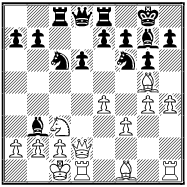
I'm thinking about my move, and after about 5 seconds he offers a draw. Here's what went through my head, all within a few seconds: "I can't castle to protect my rook on b1 since he will just take my queen with his bishop. Ne7+ obviously doesn't work. Oh he's offering a draw? Well he's higher rated and probably doesn't see any win for either side. Screw it, just take the draw." Duh. Stupid blitz. I'm such a patzer.
